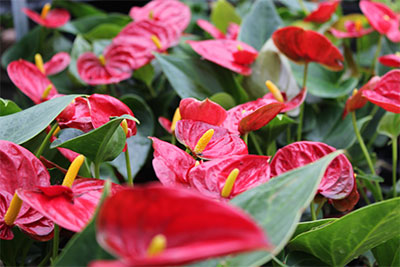Anthurium


Anthuriums are best known for their beautiful, heart-shaped spathes, and seen especially around Valentine's Day. They come in a wide range of colors, including brilliant oranges and reds, soft green or pinkish whites, and many new shades becoming readily available on the market. Most of the color can be found in the heart-shaped spathe surrounding the flowers. Although many attractive Anthuriums are grown especially for their blooms, some are becoming increasingly popular as foliage plants. Their foliage is noted for their rich shades of green or variegated with white, some with a rose color underneath. Some of the largest and the most colorful Anthuriums have been developed by growers in Hawaii. The flowering spathes of Anthurium can last an astounding six weeks, and are popular as cut flowers around the world.
1. Light
Grow Anthurium in bright light, an indirectly lit south, east or west window.
2. Water
Always water thoroughly, but allow to dry on the top inch of soil. Discard drainage.
3. Fertilizer & Care
Provide good ventilation and fertilize monthly. Repot annually. New plants can be grown by division.
4. Temperature
Ideal temperatures are 65-70 degrees at night and 75-80 degrees through the day.
5. Humidity
Native to the tropical Americas, all varieties prefer a warm and humid environment. To provide extra humidity, place the plants on a shallow tray with an inch or more of pebbles, and keep at least 3/4 inch or more of water in the tray. But make sure the bottom of the pot does not touch the water, if the pot stands in water, the plant roots will rot. The constant evaporation of the water raises the humidity in the air immediately around the plants to as much as three to five times that of the rest of the room.
6. Pet Safety
Anthuriums contain insoluble calcium oxalates, which can cause swelling and vomiting. We recommend to keep these plants away from pets.
